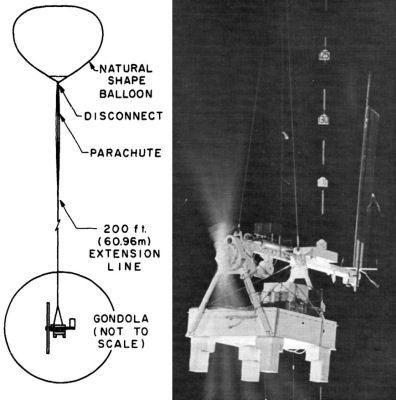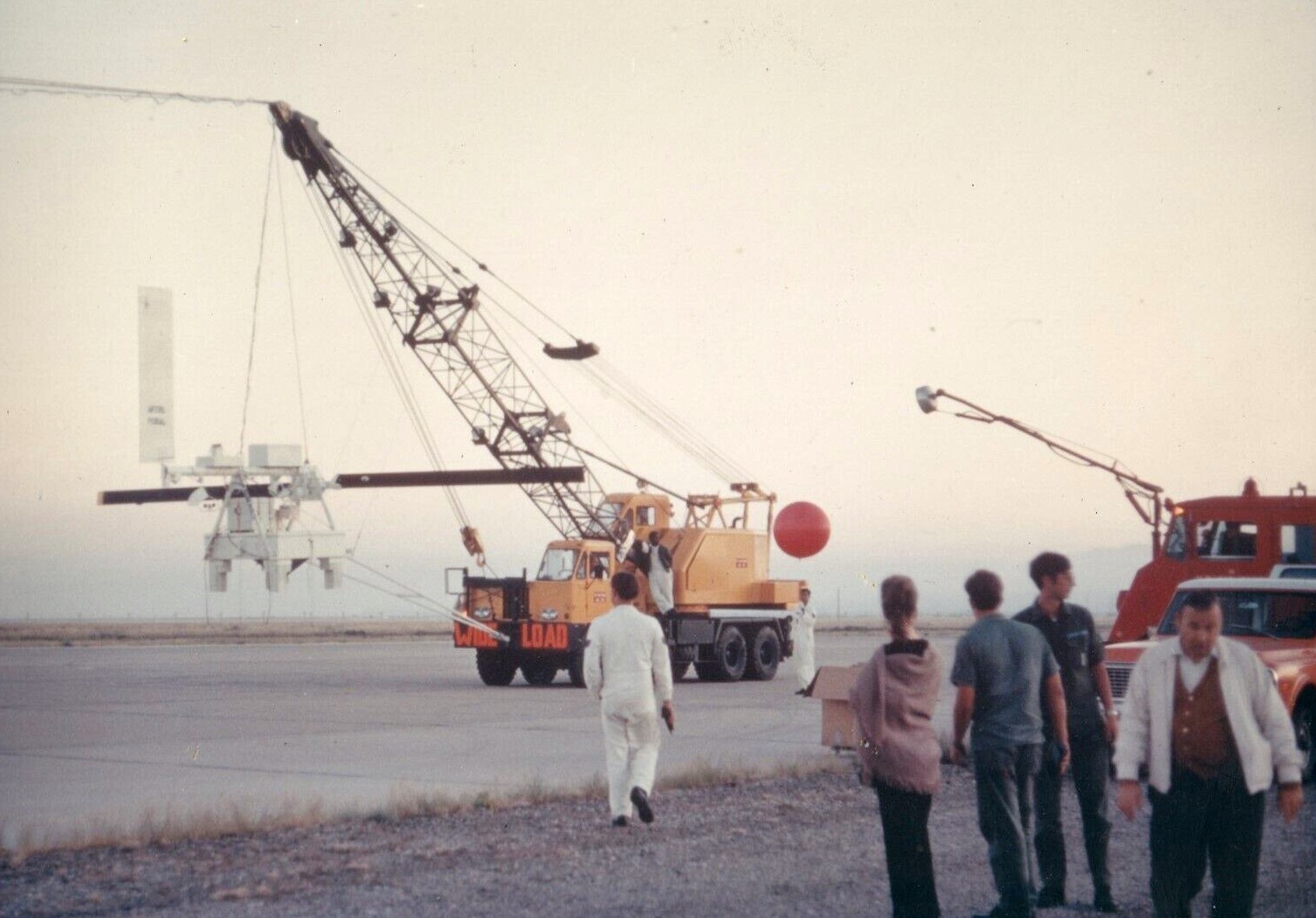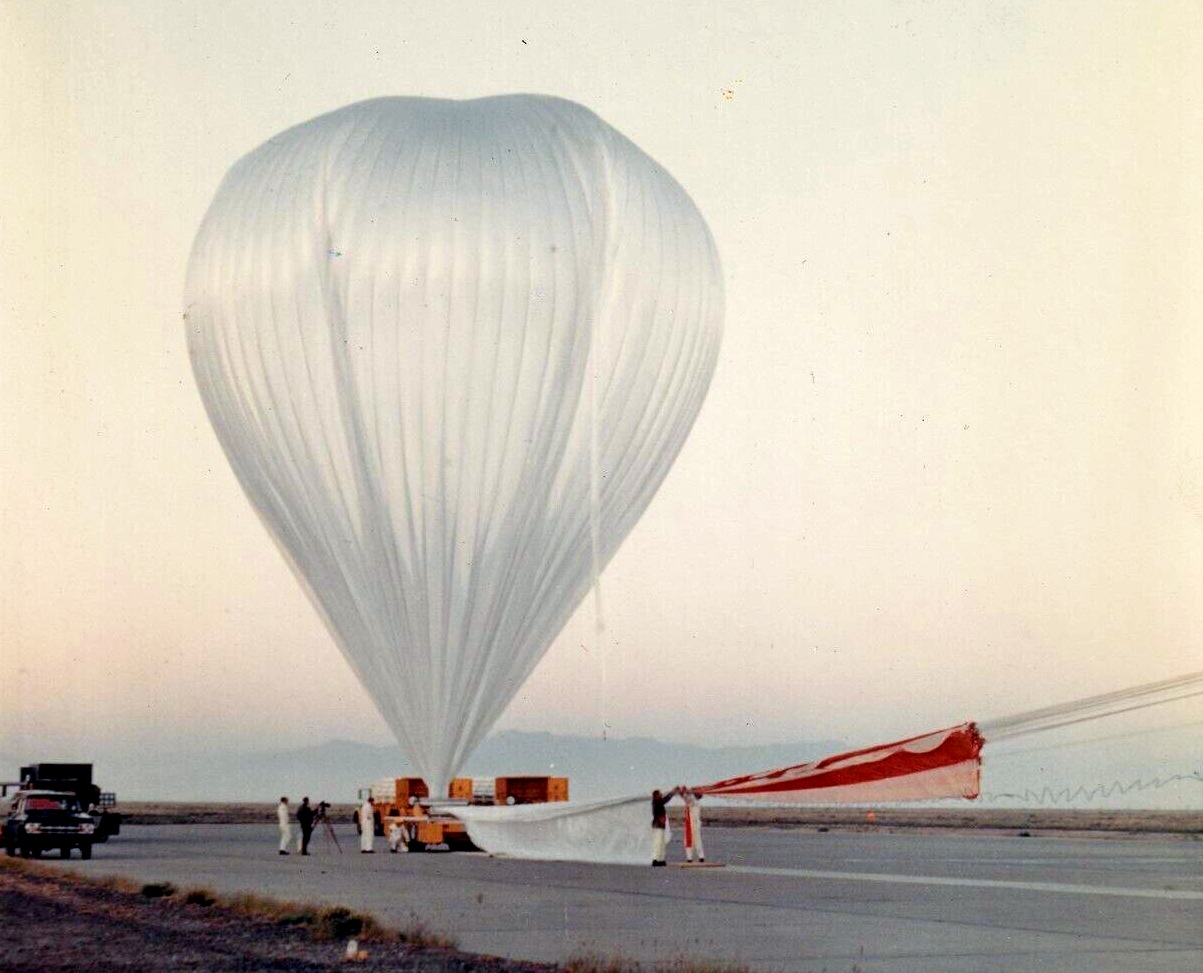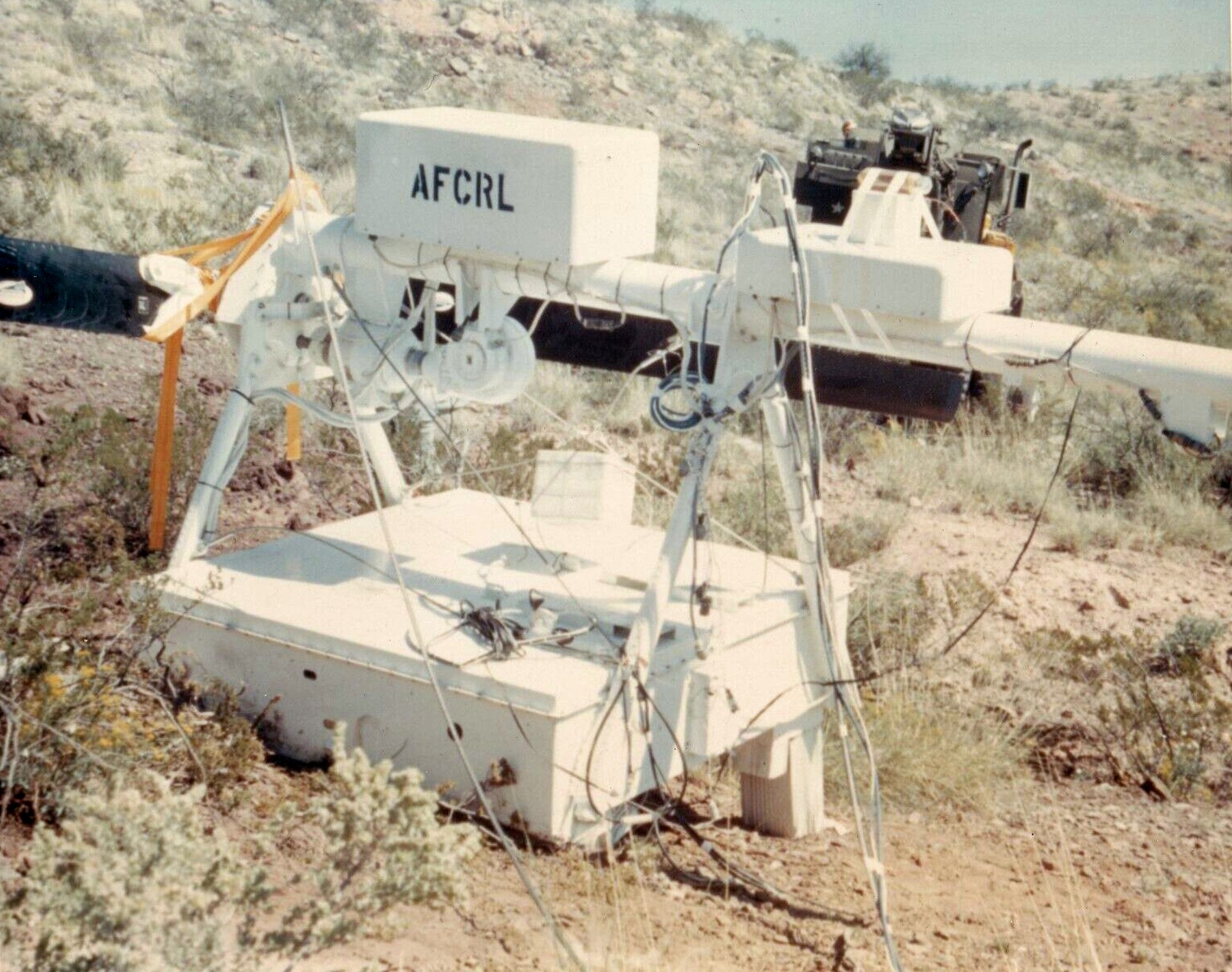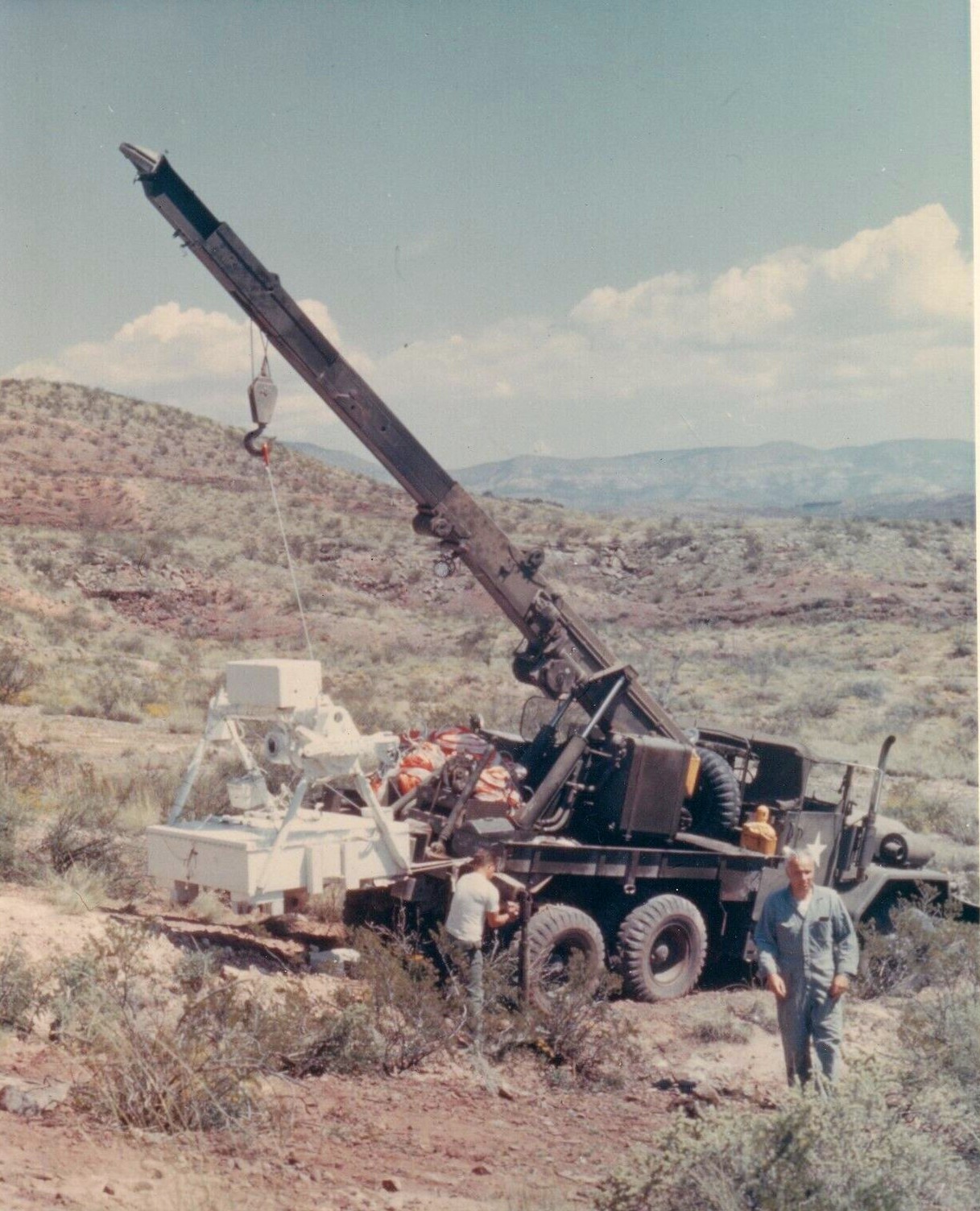Purpose of the flight and payload description
POBAL (POwered BALloon) was an experimental system developed in early 1970's by the Air Force Cambridge Research Laboratories (AFCRL) on which a propulsion unit was added to a free-flying balloon. After the discovery of seasonal occurrences of minimum wind fields in the lower stratosphere (zones where the wind speed was zero or near zero) the goal was create a system which could make possible of powering a natural shape balloon to remain in a fixed area. The design, development, fabrication and ground testing of the system was in charge of Goodyear Aerospace Corporation (GAC) while AFCRL had responsibility for the balloon, onboard instrumentation and flight test of the system.
At left we can see an scheme of the entire flight system and the propulsion gondola at full speed during a ground test (click to enlarge). The propulsion system payload consisted of the gondola structure, the power system, the rudder, rudder servo and heading autopilot, a propeller and an electric motor.
PROPULSION SYSTEM
Requirements were to provide enough-thrust to overcome the drag force (108 lb.) on the balloon in a 15-knot wind at 60,000 ft. To generate this thrust, an FH1100 helicopter rotor was selected from among commercially available propellers. This two-bladed rotor had a diameter of 35.4 ft, a chord of 10.22 in., blade twist of 0.571 degrees/feet and blade tip angle of 12 degrees. An output of 196 rpm, was required to obtain the predicted thrust at altitude. That was achieved using a Lear-Siegler starter generator motor and a gear reduction unit with a ratio of 17.28 to 1. At this gear reduction, the motor must run at 3.387 rpm. The motor power requirements where 35.2 volts and 220 amperes which were provided by silver-zinc rechargeable batteries: a bank of 368 Electric Storage Battery 2-1000 cells for propulsion, and 30 Yardney BB 405 cells for housekeeping functions and system electronics.
The directional control was supplied by a rudder measuring 8.75-ft high, with a surface of 21.9 square feet. It was placed 11.5 feet to the rear of the propeller. The rudder could be rotated 25 degrees from neutral position by autopilot, or manually from a ground-based radio command system.
GONDOLA DESIGN
The basic structure of the gondola that housed the propulsion system consisted of an aluminum sandwich platform, a horizontal tubular support assembly, and vertical triangular strut assemblies which interconnected the horizontal tube and platform. The powerplant, speed reduction unit and the propeller were mounted on the support assembly.
The batteries for electrical power were set in one tier on the platform assembly. The rudder for directional control of the gondola was pivoted to an extension boom from the support assembly. The gondola was suspended 300 ft below the balloon on a 293-lb (100-ft dia) parachute system which was flown fully extended and unopened. Four crushable aluminum honeycomb blocks located below the platform helped to absorb the impact of the landing.
An horizontal positioning mechanism for the propeller was incorporated into the design to protect it after the mission was completed. An electrically actuated pyrotechnic pin puller was also provided to hold the propeller horizontally during ground launch. An airspeed measuring device was mounted on the lower side of the aft boom. It consisted of a cup anemometer which was attached to 50-foot of nylon stored on a small reel and electrical cord. A ratchet type mechanism controled the speed of lowering the anemometer after an electrically actuated pyrotechnic pin puller released the ratchet.
In addition to the propulsion system, the gondola load included instrumentation for command, control, and telemetry and 600 lb of ballast. The total weight of the flight system including the balloon was about 4.600 lb.
The balloon for the POBAL mission was specially manufactured following AFCRL specifications, by G.T. Schjeldahl Co. using 0.5 mil Mylar with woven Dacron reinforcing fibers. It was a natural-shape single-cell balloon with a volume of 670.400 cubic feet capable of carrying about 3500 pounds of scientific and control instruments to an altitude of 60.000 feet. It was composed of 83 gores of 173 feet and had a weight of 700 lbs. It counted with two inflation tubes 150 feet long, an helium valve at the apex and 2 venting tubes each 25 ft2 x 105 feet long.
Details of the balloon flight
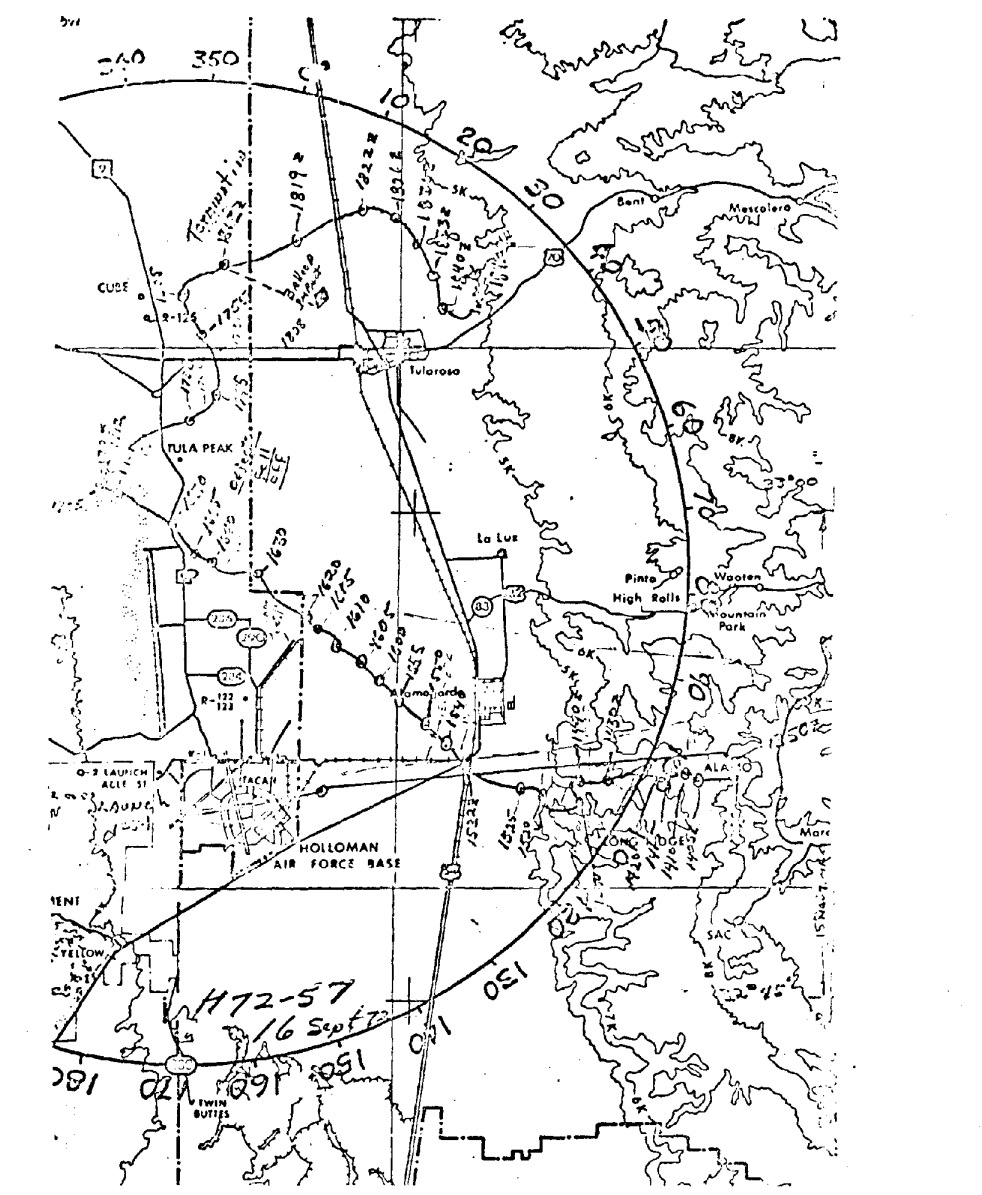
Balloon launched on: 9/16/1972 at 12:54 utc
Launch site: Holloman Air Force Base, Alamogordo, New Mexico, US
Balloon launched by: Air Force Cambridge Research Laboratories (AFCRL)
Balloon manufacturer/size/composition: Zero Pressure Balloon Schjeldahl 670.400 cuft (1.5 mils Mylar)
Balloon serial number: 1.5 NS SN:1
Flight identification number: H72-57
End of flight (L for landing time, W for last contact, otherwise termination time): 9/16/1972 at 18:12 utc
Balloon flight duration (F: time at float only, otherwise total flight time in d:days / h:hours or m:minutes - ): 5 h 18 m
Landing site: Balloon impacted 3 miles NW of Tularosa and propulsion unit 3 miles NE of the same city, New Mexico, US
Payload weight: 3839 pds
Overall weight: 4637 pds
This was the first flight test of the natural-shaped powered balloon, POBAL. It was conducted on September 16, 1972 from Holloman AFB, New Mexico.
This demonstration flight was the first opportunity to observe the performance of the propeller/propulsion unit while actually towing the balloon within the wind fields for which it was designed. Specifically, the flight was planned to assess the capability of the autopilot to steer a fixed course, of the propulsion system to achieve and sustain design airspeed of 15 knots and finaly to test the combined rudder/propulsion unit to effect a turn in the balloon trajectory.
After the balloon reached the 60,000 ft. float level, the direction and speed of the local wind was determined from the radar track of the balloon without power. POBAL was then powered on during five run cycles between 14:14 and 17:13. After the completion of the four cycle, range-tracking observers reported that an object had fallen from the system. From the performance of the gondola during the next and last run cycle, this object was identified as the rudder.
Termination was nominal. Balloon impacted 3 miles NW of Tularosa and the propulsion unit 3 miles NE of the same city.
Results of the tests
Results of the POBAL flight test indicated that it wa possible to power a natural shaped balloon against the wind. Airspeeds of 10 to 14 knots were achieved even though directional control of the gondola was marginal. The rudder must be increased in size so that a given gondola heading can be maintained for a longer period of time. Post-flight analysis indicated that rudder separation was caused by failure in the aluminum support tube due to improper heat treatment after welding.
Propeller efficiency was less than that obtained by calculation. Ground equipment and onboard instrumentation systems functioned as designed and were deemed adequate. The POBAL system was recovered without major damage. The flight was successful enough to justify reflying the system with a larger, stronger rudder and increased propeller pitch.
External references
- An Investigation of the Applicability of High Altitude, Lighter-Than-Air (LTA) Vehicles to the Tactical Communications Relay Problem AFCRL -TR-74-0399 Instrumentation Papers Nº 121
- Balloon Flight Record Nº 44 National Center for Atmospheric Research, Summer 1972
- Development of a Free Balloon Propulsion System Goodyear Aerospace Corporation, Technical Report, 1973
- LDF Powered Balloon Program AFCRL's Instrumentation Papers No.198
- Flight Summary of balloons made of Stratofilm - 1971 to 1972, Technical report, Winzen Research International. Circa 1973 - Stratocat's private collection
- Summary of Balloon Flights launched from H.A.F.B. NM (1962 thru 1987) U.S. Gov. National Archives
2458If you consider this website interesting or useful, you can help me to keep it up and running with a small donation to cover the operational costs. Just the equivalent of the price of a cup of coffee helps a lot.

